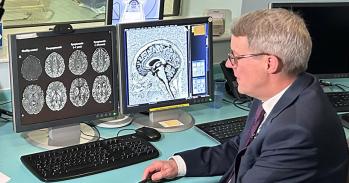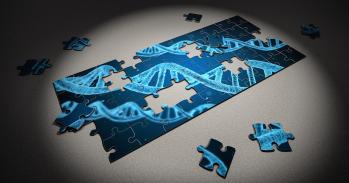
A collaboration between virologists and neuroscientists at Cambridge University has demonstrated how viruses that cross the blood/brain barrier could be exploited to slow down, or even halt, the progress of Parkinson’s and other neurodegenerative diseases.
A collaboration between virologists and neuroscientists at Cambridge University has demonstrated how viruses that cross the blood/brain barrier could be exploited to slow down, or even halt, the progress of Parkinson’s and other neurodegenerative diseases.
What we have established is proof of principle – essentially showing that this is a truly novel and highly promising pathway for treating not just the dopamine cell loss in Parkinson’s but also all cell losses in this condition, as well as other chronic neurodegenerative disorders.
Professor John Sinclair
Scientists at the University of Cambridge have made a significant step in the development of a novel therapy that could one day help to slow down, or even halt, the damage caused by Parkinson’s disease (PD), one of the most common neurodegenerative disorders. The therapy, which has been shown to be effective in rat models of the condition, involves exploiting the natural process by which common viruses protect mitochondria (the energy-producing power house of cells) in order to keep cells alive while they replicate.
The research, published this week in the Journal of Experimental Medicine, involved molecular virologists working in collaboration with neuroscientists to share their expertise across disciplines. Building on an earlier study published in 2007, the researchers have now shown proof of principle for their methodology which offers a potential novel disease -modifying approach to treating PD. The researchers’ work in harnessing the behaviour of viruses may have wider applications for the treatment of other neurodegenerative diseases - including Alzheimer’s and Huntington’s disease.
Although the age of onset varies considerably, PD is strongly associated with the elderly, with an average age of onset of around 70 years. Around 120,000 people in the UK are directly affected by the disorder with the numbers diagnosed likely to rise as the average age of the population increases. The disease results from a loss of many different types of nerve cells in the brain but especially a population that produces dopamine, a chemical that relays signals from one neuron to another. It is not known why these cells die, but when they do the people affected experience problems with walking and moving quickly.
Current treatments for PD centre on symptomatic drugs which, though they help treat some of the motor features of PD, are not able to stop the disease from progressing. Indeed, over time these drugs can produce their own side-effects.
The novel methodology developed by the Cambridge researchers stemmed from the work of Professor John Sinclair and colleagues at the Department of Medicine in studying the ways in which common viruses – such as herpes - seek to survive and replicate in cells in the body. When these viruses invade a cell, a tiny component of the virus called the Beta2.7 gene guards the mitochondria from damage for an interval of time – typically five days - so that the virus can replicate and spread from cell to cell.
In looking at how the virus gene functions, Professor Sinclair spotted the potential for harnessing this protective function to help cells survive attack by neurological disorders such as PD. The component of the virus that protects the cells’ mitochondria is a section of RNA (ribonucleic acid) which, like DNA, is essential for life. The molecular virologists led by Professor Sinclair used a method of complexing (mixing) the RNA derived from a human cytomegalovirus to a protein of a rabies virus. This protein was selected as it enables the beta2.7 to cross into the brain when the whole complex is given into the circulation, and, as only of a portion of the rabies and herpes viruses are used, there is no danger of contracting any disease from either virus.
Having identified the potential offered by the virus as an agent for ‘search and rescue’, Professor Sinclair collaborated with Professor Roger Barker and colleagues at the Cambridge Centre for Brain Repair to see whether this novel protein/RNA complex could protect neurons from cell death associated with PD. Using rat models, the results have been promising and resulted in a further tranche of research funding from the Michael J Fox Foundation to take work in the laboratory forward to help develop the novel therapeutic for eventual clinical use.
The researchers emphasise that much work remains to be done in taking the therapy to the point at which clinical trials can be undertaken. “Our results with rat models are tremendously encouraging, but we need to do a lot more in terms of refining and optimising the therapy before it could be used in patients. For example, we don’t know what the dosages or frequency of treatment might need to be in treating humans,” said Professor Sinclair.
“What we have established is proof of principle – essentially showing that this is a truly novel and highly promising pathway for treating not just the dopamine cell loss in Parkinson’s but also all cell losses in this condition, as well as other chronic neurodegenerative disorders.”
The novel therapy offers a number of significant advantages over all currently used surgical and drug therapies. Professor Barker explained: “In many ways the therapy we’ve developed is a beautiful treatment. It can be delivered through an injection direct into the bloodstream, for example into the arm of the patient. This makes it much easier to use than many other putative disease-modifying therapies such as growth factors which have to be injected directly into the brain. This new agent also appears to be non-immunogenic – in other words it does not trigger an immune response so it can be used repeatedly and should still maintain its potency. Finally, it appears to go only into the brain and nowhere else in the body and then to target only cells that are unwell.”
The next stage of the research will be to test the novel therapy in other models of PD to help define the dosage and time course of delivery.
This work is licensed under a Creative Commons Licence. If you use this content on your site please link back to this page.





